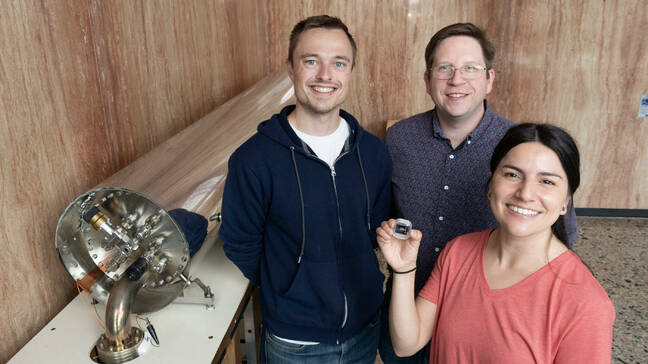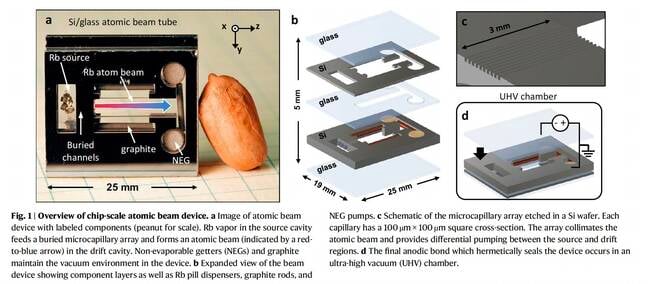NIST boffins shrink atomic beam clock to the size of a postage stamp
It's not the most accurate atomic clock in the world, but the NIST team behind it believes they can fix that
There's a new atomic clock on the block over at the US National Institute of Standards and Technology (NIST), and while it's not as accurate as its predecessors it does have one big advantage: it's small enough to stick in your pocket.
The chip-scale beam clock (CSBC) is tiny – just around the size of a postage stamp – and it relies on previously established technologies for measuring time via atoms developed at NIST.

NIST's Alexander Staron (left), William McGehee and Gabriela Martinez show off the new CSBC they developed. Image: NIST
Now hold on, you may be thinking: NIST has had tiny atomic clocks since the early 2000s when it developed the chip-scale atomic clock or CSAC. That's true, and this wee device takes inspiration from CSACs. What makes this one different is the process it uses to measure atomic resonance frequencies: atomic beams, just like the giant, stationary atomic clocks long used as the US standard for measuring time.
"The CSAC is low-power and has high performance given its size. It's a wonderful device, but it does drift after running for a few thousand seconds," said NIST physicist and CSBC paper co-author William McGehee. CSACs tend to lose more time when the gas surrounding atoms in their tiny chambers change temperatures. That's a frequent concern given CSACs tend to be used in applications like underwater oil and gas exploration, military navigation and telecommunications, all of which could find CSACs exposed to a variety of conditions.
The CSBC experiment, McGehee added, was all about figuring out if combining CSACs and beam clocks was even possible, and it appears it is.
A tiny beam scheme
Atomic beam clocks – the most recent of which was NIST-7, the US time keeping standard from 1993 to 1999 – have been mostly replaced with the more accurate, and even larger, atomic fountain clocks.
Lest you think they're obsolete, beam clocks are still useful for measuring time, with state-of-the-art models only expected to experience a one second drift every million years. Recent fountain clock designs have achieved a one second drift over 100 million years – hyper-accurate, but not practically necessary in situations where smaller is better.
Microwave cavities in beam clocks have to be quite large, hence their bulky size – NIST-7 was more than eight feet long – but microfabrication techniques used to develop CSACs opened up the possibility of developing tiny beam channels only 100 micrometers wide and 10mm long built into a device made from stacked layers of etched silicone and glass.
Rubidium is used as the source material, which is heated to excite the atoms and get them beaming through the channels. To prevent inaccuracies from gas molecules in the chamber the team included materials called non-evaporable getters, or NEGs, which can collect gasses as well as pull the rubidium atoms along. Tiny graphite rods are also included to collect stray atoms that could affect measurements.
Despite its innovative design and the fact that it was shown to work, the experimental CSBC still isn't that accurate, and performs "at a level slightly worse than existing CSACs," NIST said. The team still thinks it has a path forward, though.
- US government extends software security deadline because vendors aren't ready
- Are we springing into a Y2K-class nightmare?
- Orolia inks €70m deal to provide atomic clocks for second generation of EU's Galileo navigation satellites
- Australian geoboffins have zoomed in and enhanced CSI-style soil analysis: Bung it in a machine, find the crime scene
"The presented beam clock approach has the potential to exceed existing chip-scale atomic clocks in both long-term stability and accuracy," McGehee and his team wrote in their paper. Doing so would require eliminating common causes of drift that were found during the 15 months (41.45 Scaramuccis or 10.4 Trusses, for those keeping count via El Reg units) the CSBC ran for testing purposes.
While noting that the device functioned for more than a year "without degradation of the vacuum environment or saturation of the passive pumps," the team noted that Doppler and Zeema shifts, end-to-end cavity phase shifts, collisional shifts and light shifts, among others, all contributed to drift in the CSBC during tests.
Future tests, the team said, will try to improve stability by integrating micro-optical and thermal packaging that would increase the size to that of a standard CSAC (which NIST notes is around the size of a piece of sushi) but hopefully make it more resistant to the shifts that affected its test performance.
If successful, the team believes their design could be used for quantum sensing, inertial sensing using atom interferometry, electrometry and the construction of "higher-performance compact clocks using optical transitions," the researchers predict.
"Considering each of the common sources of drift … an ultimate fractional frequency stability at or below the level of [a CSAC] appears feasible in a chip-scale atomic beam clock," they conclude. ®

 Biting the hand that feeds IT
Biting the hand that feeds IT